Physical Address
304 North Cardinal St.
Dorchester Center, MA 02124
Incorporation of a diet and exercise program in conjunction with liposuction will allow patients to achieve their optimal shape and contour. Patients who do not adhere to diet and exercise are least happy with their results.
A thorough history and physical exam should be performed and a preoperative clearance obtained when necessary.
Over-the-counter herbal and diet medications may have unfavorable interaction with surgery and/or anesthesia and should be discontinued 3 weeks prior to surgery.
Knowledge of the differing thickness and consistency of fat throughout the body is crucial to determining proper depth and technique for each region of the body.
Superficial liposuction should be reserved for significant superficial irregularities or for the experienced surgeon performing more advanced liposuction techniques.
Wetting solutions should always be used, and a strict record of volume infused and aspirated should be kept by the operating room personnel.
Surgical access sites should be concealed, often asymmetric, and utilized to allow the best access and treatment results. Excessive use of a single access incision may result in a deformity.
Patients with surgical scars on their abdomen must be thoroughly examined to rule out the presence of a hernia.
There are many tools one can use to perform liposuction. Physician experience and judgment supersedes any technology.
Contour irregularities are best diagnosed at the time of the surgical procedure. If noted, strong consideration for equalization or immediate fat grafting should be considered.
Postoperative contour deformities should be clinically evaluated and, if mild, can respond to lymphatic massage or other non-invasive methods. A systematic approach should be used to correct contour deformities when they occur.
Access video lecture content for this chapter online at Elsevier eBooks+ ![]()
Suction-assisted lipectomy, lipoplasty, or more commonly referred to as liposuction, originally introduced by Illouz in the early 1980s, continues to be one of the most popular means of body contouring and overall treatment modalities offered in aesthetic surgery today. According to the American Society of Plastic Surgery and the Aesthetic Society, liposuction was the most popular plastic surgery surgical procedure performed. With greater understanding of the biochemical and physiologic properties of liposuction, as well as biomedical technological advancements, suction-assisted lipoplasty has undergone tremendous evolution leading to overall improvements in technique, patient safety, and outcomes. Liposuction has evolved from a procedure that facilitates small or spot reductions to one that has become an almost irreplaceable tool in the aesthetic surgery armamentarium in neck, breast, and circumferential body contouring. Liposuction has become a useful adjunct to other areas of plastic surgery, including breast reconstruction and postoperative contouring in upper and lower extremity reconstruction. A number of important innovations and modifications to the standard suction-assisted liposuction (SAL) have progressively refined the procedure; these include the use of wetting solutions; advances in cannula design; ultrasound-assisted liposuction (UAL); power-assisted liposuction (PAL); VASER-assisted liposuction, and SAFE liposuction technique. There has been a strong movement concentrated on defining appropriate safety guidelines for liposuction and other body contouring procedures focusing on deep venous thrombosis (DVT) prophylaxis and fluid resuscitation ensuring safety and efficacy of the different treatment modalities for our patients.
Even with these refinements, liposuction, as with all invasive procedures, is not without risk. Aesthetic body contouring with liposuction requires a complete knowledge of the anatomic, biochemical, and physiological components of the different modalities and their limitations and indications in order to perform the procedure in a safe, controlled manner. Using a coordinated approach along with a thorough understanding, liposuction can be performed safely with relatively predictable results and outcomes.
Anatomy texts divide subcutaneous fat throughout the body into superficial and deep layers or compartments separated by Scarpa's fascia, or the superficial fascial system. However, for the purposes of liposuction and body contouring, subcutaneous fat is arbitrarily divided into three layers: superficial, intermediate, and deep ( Fig. 25.2.1 ). The importance of this distinction is that the superficial layer is one that should be approached with caution and by those with a strong foundation and experience in liposuction. If this layer is treated, there may be vascular compromise and/or a significantly increased risk for contour irregularities. The relative consistency and thickness of each of these separate layers varies for different anatomic areas. For example, the fat of the back has a more fibrous, compact superficial and intermediate layer, with an underlying loose, areolar layer. This contrasts with the fat of the inner thigh, which is not as fibrous and is less compact. This is critical information for the aesthetic surgeon in order to perform safe and appropriate suctioning of the targeted area, while minimizing potential contour irregularities and skin necrosis. The variation in fat consistency and depth will be discussed further, as it relates to safe suctioning techniques and the choice of modality for the most effective treatment.
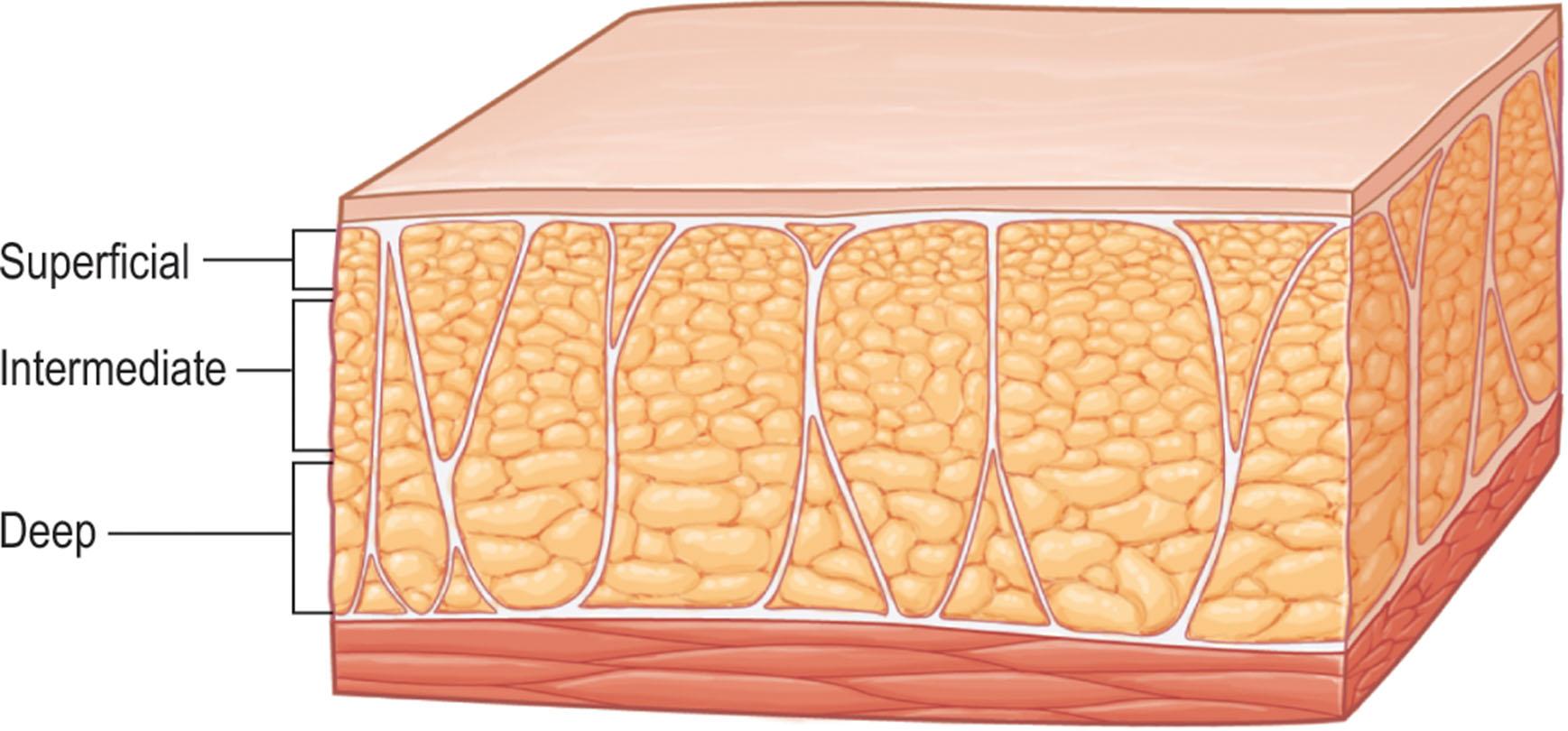
Anatomic “zones of adherence”, which are present in both men and women, are important to identify and note during the preoperative consultation. These are areas of relatively dense fibrous attachments to underlying deep fascia, which help define the natural shape and curve of the body. There are gender-specific variations with respect to each of these zones ( Fig. 25.2.2 ). It is important to recognize these zones, as they are identified as high-risk areas for contour irregularities after surgical intervention if not properly respected. However, these are not areas to avoid in all cases and, on occasion, help guide the surgeon in establishing “contour goals” for surgical intervention. Regardless of the tool used for liposuction, it is helpful to consider the treatment area in terms of the three surgical layers. These arbitrary layers help delineate areas of safety when performing liposuction. The most common areas treated are the intermediate and deep layer. Treatment of these layers allows uniform reduction without risk of injury to the subdermal plexus and unwanted skin injury.
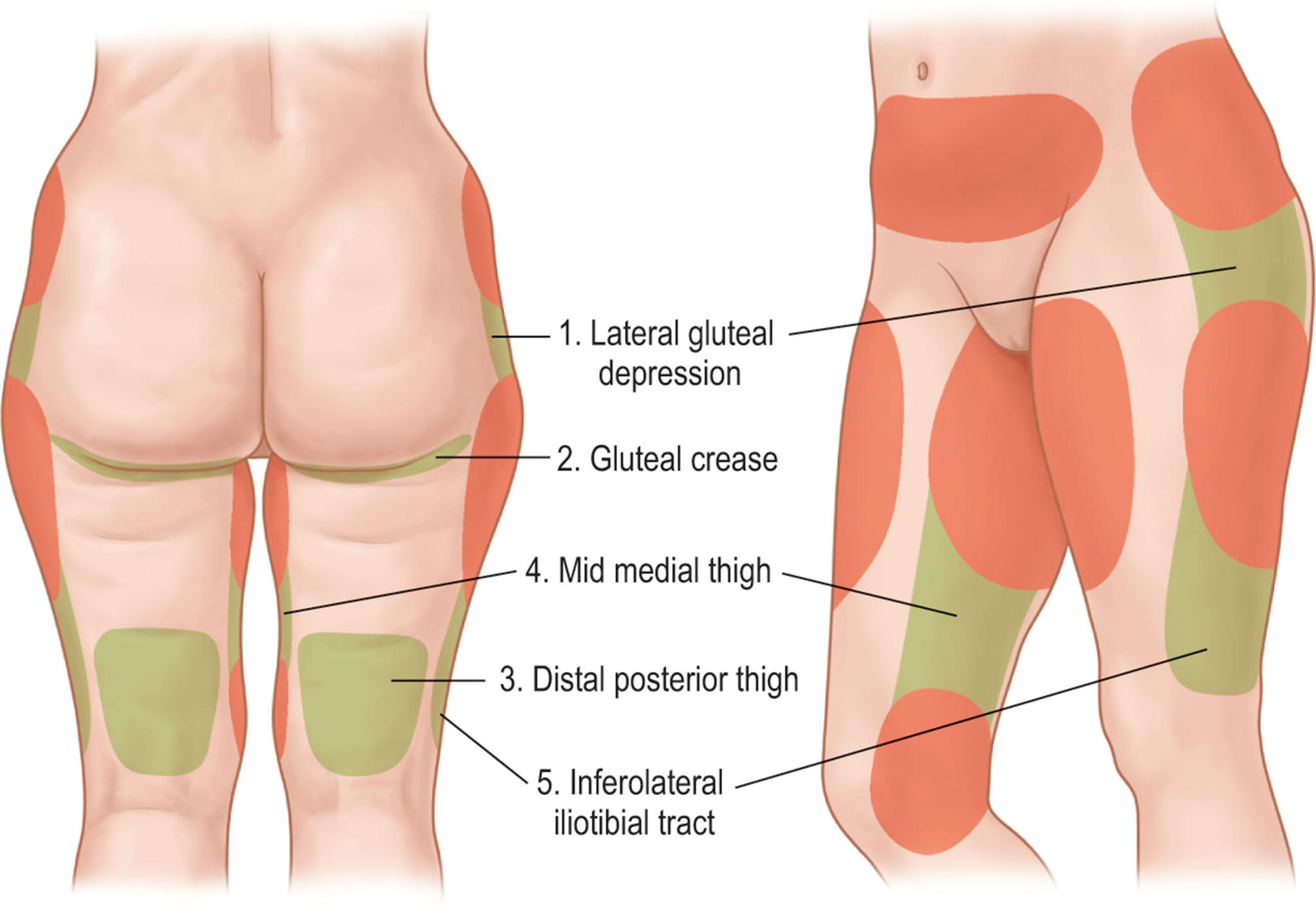
It is helpful to classify patients based on the three types of lipodystrophy and skin redundancy ( Fig. 25.2.3 ):
Type I: localized lipodystrophy . Often younger patients with good skin tone and minimal skin irregularities.
Type II: generalized lipodystrophy . These patients tend to have slightly diminished skin tone with some skin irregularities and circumferential lipodystrophy throughout their trunk and extremities.
Type III: skin redundancy and lipodystrophy . Patients displaying significant skin redundancy that would be more amenable to excisional surgical techniques to improve shape and contour. If necessary, liposuction may be a useful adjunct in order to achieve an optimal result.
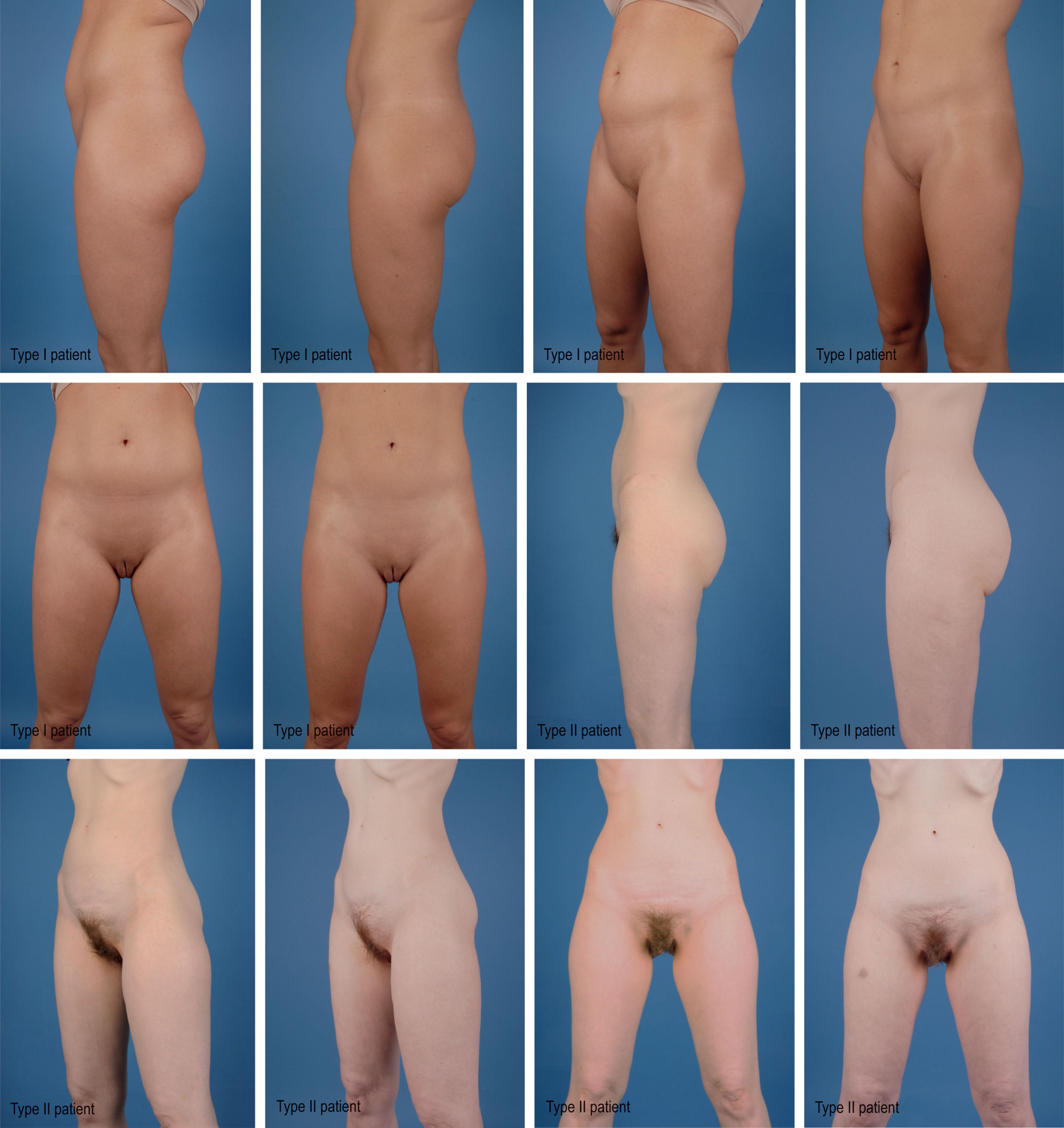
Cellulite is a skin condition that is often seen when evaluating patients for liposuction. Cellulite is a dimpling of the skin, particularly in the areas of thighs and buttocks. It has a poorly understood pathophysiology but is thought to be related to fibrous, dermal attachments to the underlying fascia and surrounding hypertrophied fat. It has a hormonally mediated component. A range of surgical and non-surgical techniques have been described for treatment of cellulite, all with the similar goal of disrupting the fibrous septae that separate the fat. These have ranged from liposuction with aggressive cannulas with fat grafting, 1440-nm pulsed laser, needle or blade subcision release, and more recently, injection of collagenase. There is no high level evidence comparing the efficacy of these techniques. Any provider should carefully approach the treatment of this difficult pathophysiology. This should be clearly delineated to the patient as the goals of surgery are reviewed.
Liposuction patients often present with a variety of expectations, concerns, and/or complaints. In order to achieve optimal contour with liposuction, appropriate patient selection is imperative. As a general rule, liposuction is performed in healthy patients who maintain realistic goals and expectations. Studies have shown that patients who undergo proper long-term lifestyle changes will in fact achieve the highest level of postoperative satisfaction from their liposuction-assisted body contouring procedure. Rohrich et al . concluded that those patients who were committed to a positive lifestyle change involving a healthy diet and regular exercise, or who were already practicing a “healthy lifestyle” that continued postoperatively, experienced the best self-assessment and satisfaction scores with liposuction postoperatively ( Fig. 25.2.4 ). A successful body contouring patient must satisfy four key elements to achieve and maintain optimal results:
Lifestyle change.
Regular exercise.
Well-balanced diet.
Body contouring.
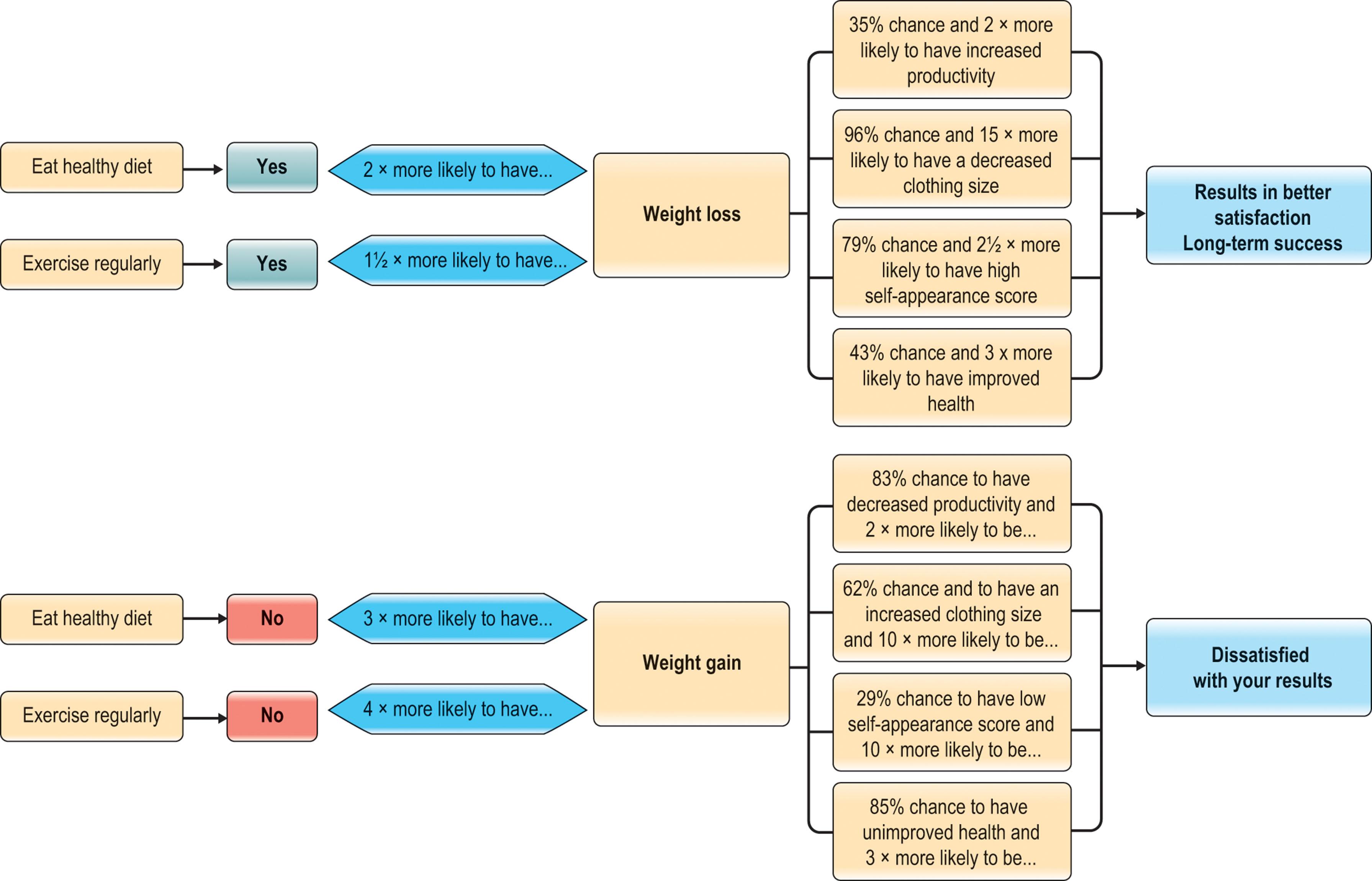
Appropriate candidates for liposuction are not morbidly obese, are of a stable weight, and have incorporated the above lifestyle changes into their preoperative regimen. It is preferable for patients to commit to the necessary changes in diet, exercise, and lifestyle modification before undergoing surgery. It is the responsibility of the surgeon to address all concerns, expectations, and goals prior to the procedure in order to establish realistic expectations of the procedure to the patient. Preoperative consultation with a dietician may prove beneficial for long-term patient satisfaction. Liposuction is contraindicated in patients who are pregnant or in poor general medical health. Patients with morbid obesity, cardiopulmonary disease, body image perception issues, unrealistic expectations, wound healing difficulties, or who have extensive or poorly located scars should be excluded from consideration for liposuction.
During this initial interaction, it is imperative that the plastic surgeon can assess the patient's goals of surgery and be able to determine if the patient has realistic expectations regarding outcome and postoperative body image. It may be useful to have the patient prioritize the body regions that they are most concerned with, while focusing on specific complaints within these areas. A detailed medical history should be obtained, including any medications, allergies, and tobacco or marijuana use. Especially important are notations in the medical history of diabetes, massive weight loss, previous surgery, previous liposuction, and a full detailed list of medications and supplements. Any concerns about a patient's medical suitability to undergo anesthesia and/or an operative procedure should result in referral for preoperative clearance with either an internist, cardiologist, or an anesthesiologist. The patients need to be asked specifically about herbal and over-the-counter medications, because these are frequently omitted. Non-essential medications should be discontinued at least 3 weeks before surgery. In selected patients, a preoperative evaluation by a primary care doctor, internist, or cardiologist may be warranted. This typically includes anyone with a significant medical history, or patients older than 50 years of age.
When longer operative times are planned, it may be prudent to notify the consulting physician of expected operative times and the amount of expected aspirate and infiltrate. Often, our medical consultants view liposuction as a very benign operation with minimal operative time and morbidity, when, in fact, a large-volume liposuction case can have significant fluid shifts and time under general anesthesia. Massive weight loss patients should undergo the same preoperative evaluation and clearance for liposuction as they would for any excisional-type body contouring procedure (including nutrition, hemoglobin, iron, vitamin B 12 , etc.). It is safest to refrain from operations until these lab results are normalized. Herbal remedies and supplements are not regulated by the Food and Drug Administration (FDA) and thus may place the patient at potential risk of untoward complications, including bleeding or hypercoagulability and should be avoided in the perioperative period. Avoiding aspirin, non-steroidal anti-inflammatory drugs (NSAIDs), and hormonal therapy can help prevent such complications as well. It is the authors' policy for patients to discontinue use of all NSAIDs, aspirin products, fish oil, and supplements 3 weeks prior to surgery. Of course, if there is a medical indication and necessity for these drugs, consultation with the primary physician or appropriate specialist should be completed before discontinuation of the medical therapy. A frank discussion of the risk of oral contraceptives and estrogens is held with the patient regardless of the magnitude of the procedure. We strongly recommend that these medications be discontinued 1 month prior to the operative procedure, and an alternative method for birth control in the perioperative period.
Patient goals must be clearly elucidated, and realistic expectations must be established. This is particularly important when more superficial liposuction or “liposculpture” is planned, which is a difficult and time-consuming procedure with a high learning curve that is appropriate only for highly experienced surgeons. Authors such as Hoyos and Steinbech have popularized high-definition liposculpture, an “expanded liposuction” technique defined by a combination of deep fat removal with select superficial fat contouring with or without fat grafting or equalization in select muscular areas. This technique has been described in the abdomen, arms, back, shoulders, buttock, thighs, calves, and chest. Regions of muscular concavity are suctioned in a deep and superficial plane, and regions of muscular convexity are potentially augmented with fat grafting. The goal of select superficial and deep plane liposuction in high-definition liposculpture is to highlight the underlying “shadows” and muscular transitions to accentuate the underlying variable muscular definition that is dependent on body shape and gender. Caution should be exercised in superficial liposuction, as contour irregularities are more likely and these regions are dynamic with variable presentation depending on patient body habitus; unnatural appearance may result if transition zones to blend these dynamic areas are not marked and treated appropriately.
A detailed physical exam is performed at the first visit and consultation. Specific attention to skin quality, prior scars, presence or absence of hernias, evidence of venous insufficiency, and presence of pre-existing asymmetry or contour irregularity should be discussed and noted in the chart. At the initial and subsequent visits, height and weight with calculation of body mass index (BMI) is paramount for safety, as well as for observation of long-term trends during follow-up. For liposuction candidates, six key elements are documented:
Evaluation of areas of lipodystrophy and contour deformities.
Skin tone and quality.
Asymmetries.
Dimpling and cellulite.
Myofascial support/presence of hernia(s).
Zones of adherence.
The physical exam begins in front of a full-length mirror ( Fig. 25.2.5 ). This allows an open dialogue between patient and physician, wherein the patient's concerns can be addressed and previously unrecognized problem areas can be assessed and addressed. Any areas of cellulite should be pointed out to the patient, and a specific discussion of expected outcome in these areas should be noted. While the patient is in a supine position with the head elevated, abdominal integrity is examined ( Fig. 25.2.6 ). This is helpful for detecting hernias or myofascial diastases. Findings may be difficult to interpret in larger individuals, males, or patients with multiple scars. An ultrasound examination or computed tomography (CT) scan may further clarify this region and prevent potential intra-abdominal injury in these challenging patients. During the initial consultation, when the patient is in front of the mirror, it is important to point out potential problem areas that may cause less than optimal results, so the patient may visualize and appreciate these areas.
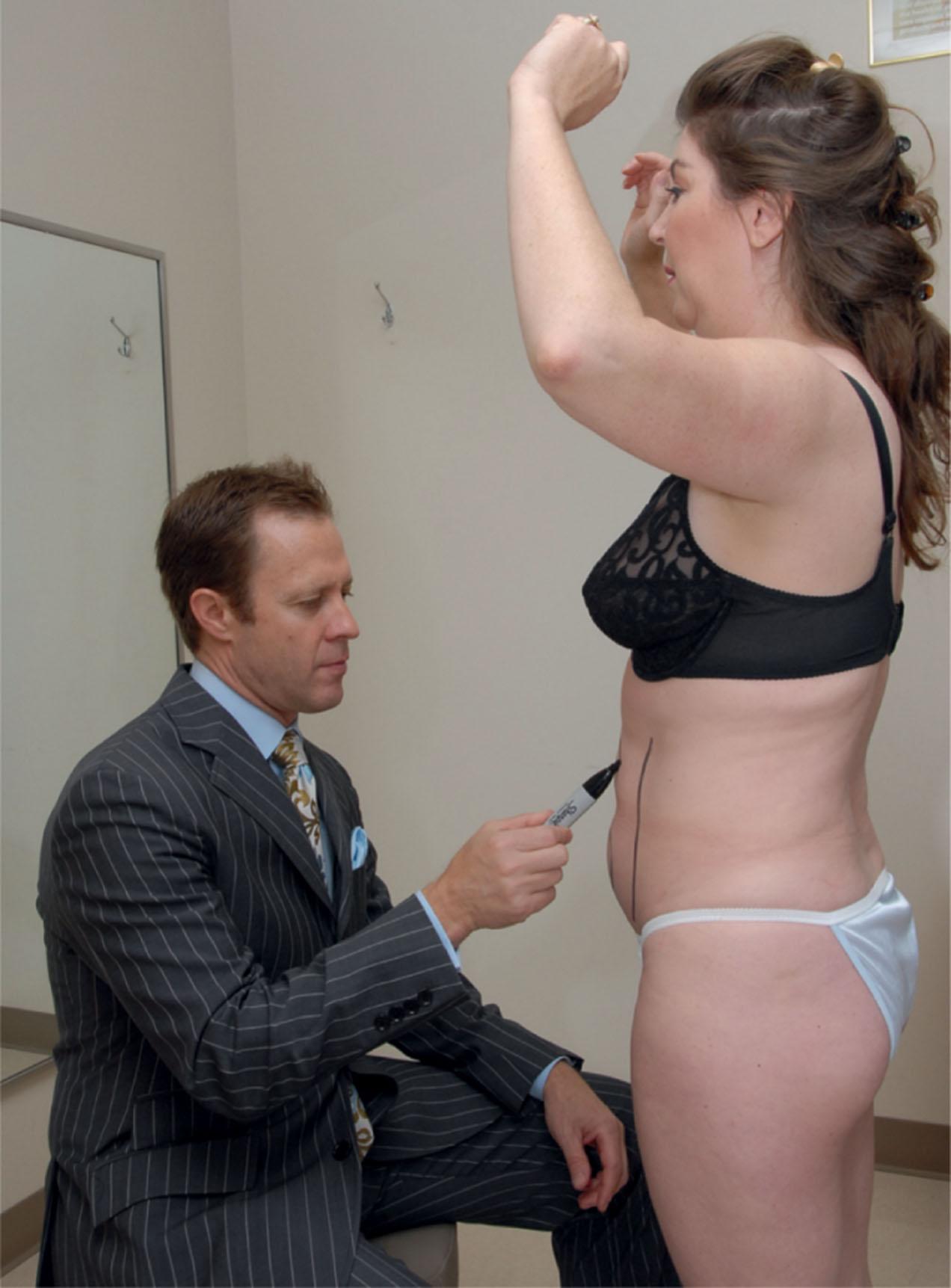
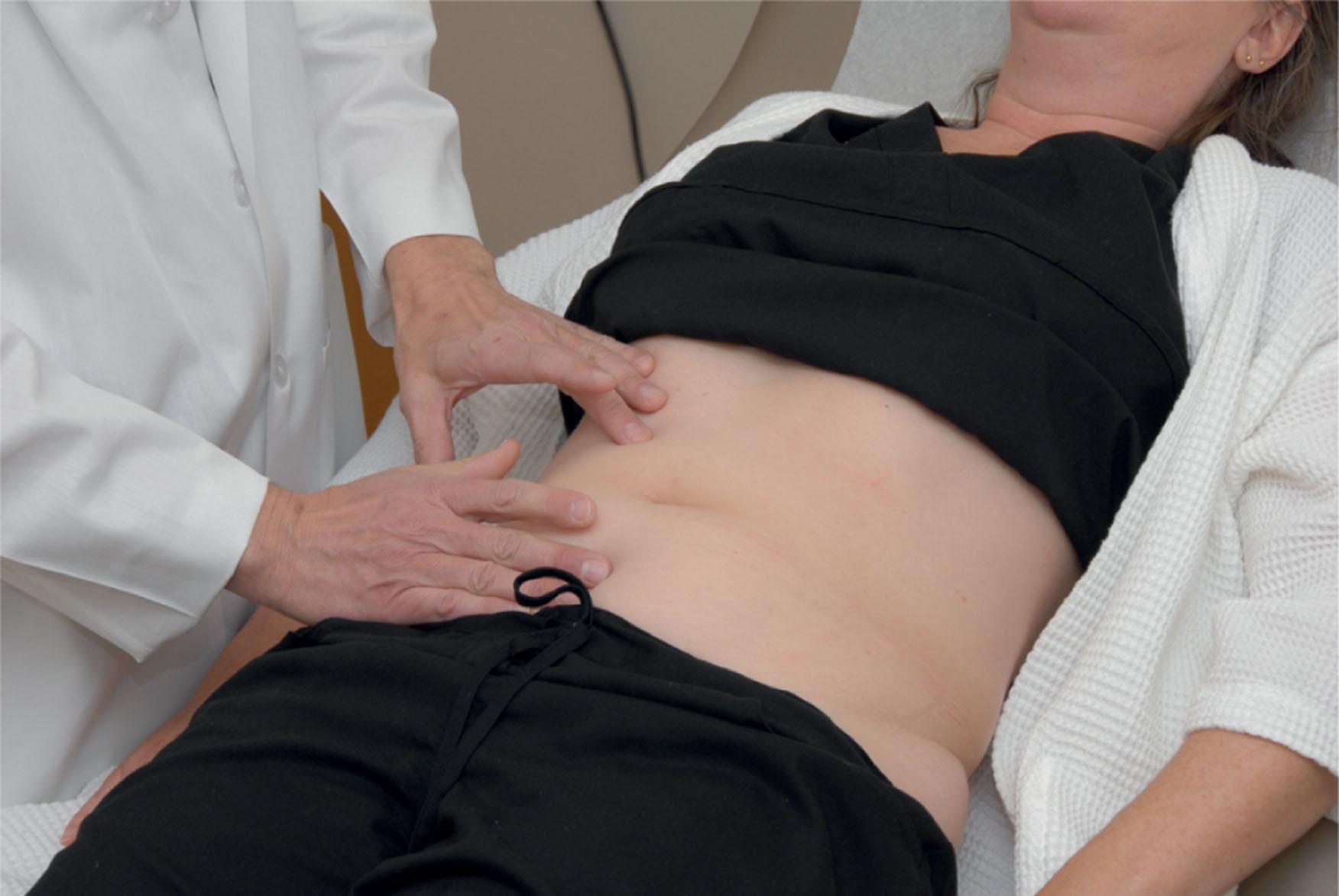
At the initial evaluation, high-quality medical images should be obtained, with anterior, posterior, lateral, and oblique views. This will allow for documentation of results, as well as objective evaluation of outcomes by both patient and physician. Professional medical photography can be a very useful tool for accurate and consistent pre- and postoperative documentation. If superficial liposuction or “liposculpture” is planned, a detailed exam of the subcutaneous fat distribution is essential. Attention must be paid to “gender ideal” muscular shape, mass, and fat distribution. Additionally, dynamic areas must be examined and marked in the full range of muscular contraction to yield natural results. Inattention to these details may result in unnatural appearances and contour irregularities.
A follow-up visit is typically scheduled 2–3 weeks after the initial consultation. During this visit, computer images ( Fig. 25.2.7 ) are potentially reviewed, which allows the patient to establish realistic expectations. These objective images portray the advantages, disadvantages, and limitations of body contouring surgery. The patient should understand that imaging is for educational purposes only and is not a guarantee of the final result. The second visit allows further dialogue between the patient and physician so that all questions may be answered and issues addressed. For example, a second opportunity to address any last minute concerns by the patient in regard to recovery time, pain control, bruising, and postoperative changes will help strengthen the patient's confidence in the procedure and decrease the likelihood of any uncertainties or surprises within the perioperative period. The second visit may be structured in a HIPAA (Health Insurance Portability and Accountability Act) compliant, virtual consultation setting for patient convenience.
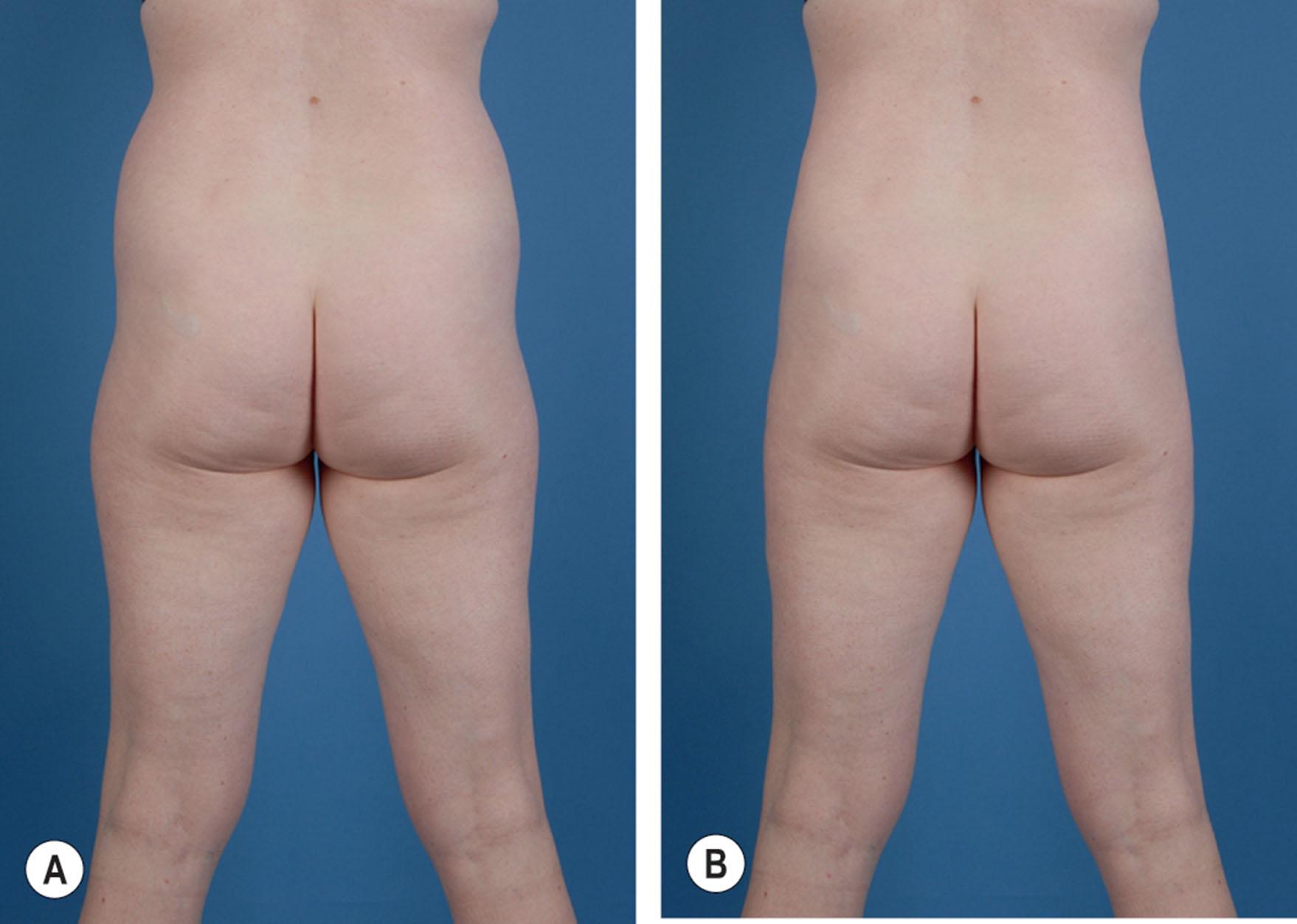
Patient education is stressed throughout the course of the initial evaluation, physical examination, and follow-up visit so that the patient has sufficient information about the procedure, postoperative course, and long-term results to make a truly informed decision. The patient and physician should discuss the procedure itself, alternative treatments, financial obligations (including further surgeries if required), and complications and risks. The risks for liposuction include, but are not limited to, bleeding, infection, pain, thermal injury, seroma, dyspigmentation, paresthesias, contour irregularities, and dysesthesias. Large-volume liposuction carries increased risks of fluid shifts, volume overload, anesthesia-related complications, and fat related complications such as fat embolism. These problems are discussed under “Complications”, below. Informed consent is vitally important in the evaluation and management of liposuction patients, to protect the surgeon and the patient from unexpected outcomes or patient dissatisfaction. This important process should be performed by the operative surgeon (not a nurse or staff) and clearly documented in the medical record.
Guiding marks are performed prior to surgery with the patient in the standing, upright position. In patients undergoing total body liposuction or contouring in combination with excisional surgery and/or fat transfer, marking can be done in the office the day before surgery. This allows for a more private environment and ample time to review the plan with the patient including review of preoperative markings and photos. Marking is done in front of a mirror, thus allowing the patient to contribute to the process, and further confirms exactly what will be addressed during the procedure. Areas to be suctioned are marked with a circle; zones of adherence and areas to avoid are marked with hash marks. Asymmetries, cellulite, and dimpling are marked for their respective treatment and to allow patients to see problem areas highlighted. When complete, the marks are once again reviewed with the patient to ensure that all areas of concern are addressed. Access incisions are also marked at this setting. Often two incisions are needed per area to be treated; these incisions should be placed adjacent to suctioned areas and not too distant. With liposuction, it is beneficial to choose access points that can treat multiple areas when possible. That being said, incisions are small and typically heal well so should be utilized liberally to achieve cross-hatching of the area and an ability to contour from multiple sites, allowing for more uniform reduction and decreasing the risk for access site depression. Care should be taken to prevent access incision placement in or adjacent to zones of adherence. The suctioning may cross the zone and disrupt it. Incisions should also allow each area to be treated from different directions for optimal contouring. Incisions should be no longer than 3–5 mm in length and placed in well-concealed areas. The surgeon should not hesitate to place additional incisions if access is insufficient with the existing markings. The use of skin protectors is preferred to prevent friction induced thermal injury to the skin and subcutaneous fat at the cannula access port location.
Fig. 25.2.8 shows the preoperative markings and preferred placement of access incisions based on areas to be suctioned. Cosmetically, it is preferable to stagger incisions in an asymmetric fashion to camouflage their appearance.
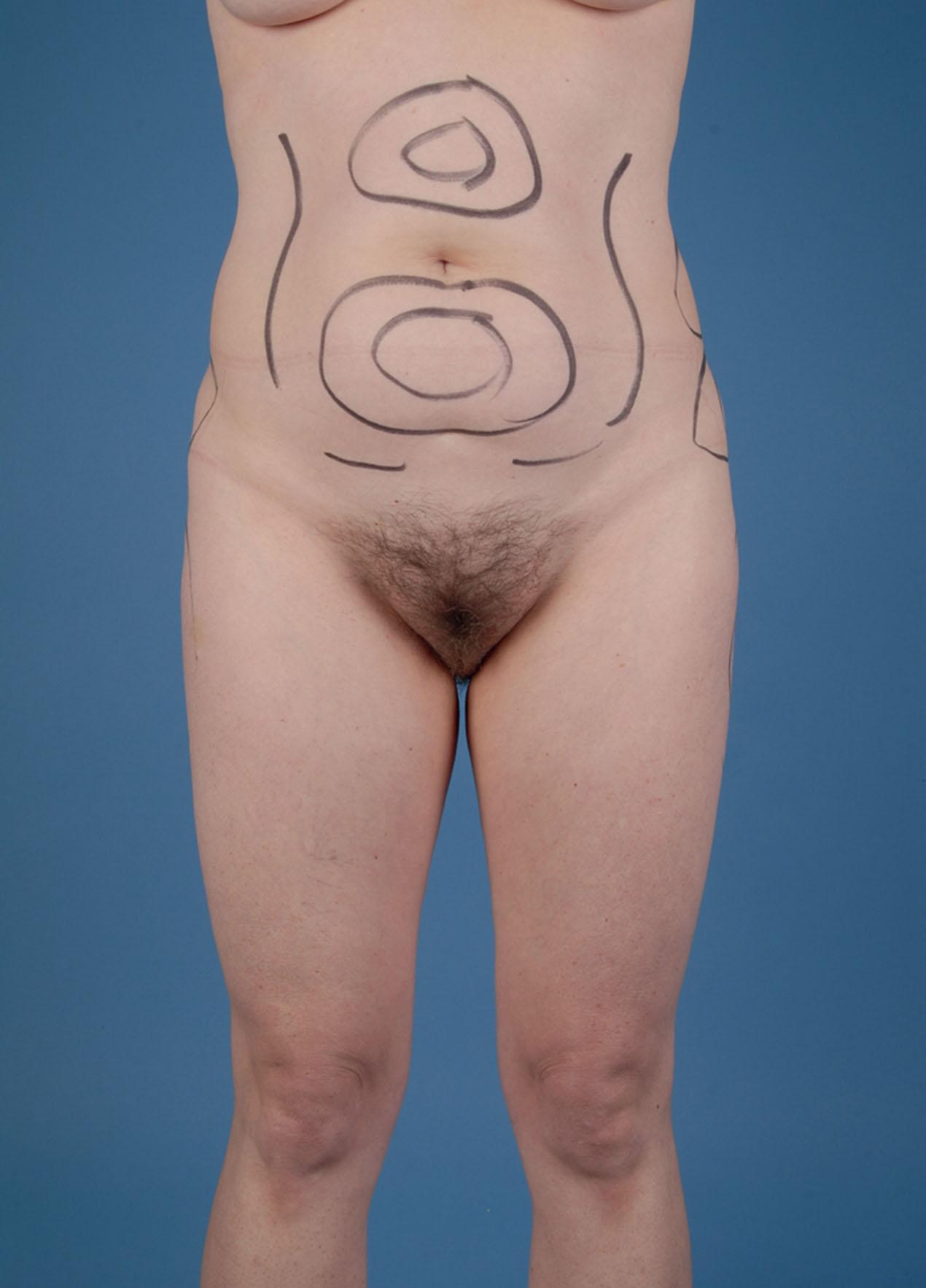
It is up to the surgeon to determine the optimal surgical setting for each patient undergoing liposuction. Factors that influence this decision are the amount of expected lipoaspirate, length and extent of procedure, patient positioning, operating surgeon preference, anesthesiologist preference, and overall health of the patient. Depending on the geographical location, there are differing regulations for the location of liposuction procedures, usually based on the type of anesthesia and the area or total lipoaspirate volume of the liposuction procedure. For example, one recommendation is to avoid epidural and spinal anesthesia in office-based settings because of potential hypotension and volume overload issues.
As a general rule, small-volume liposuction cases can be performed with local anesthesia, with or without mild sedation. Complex, large-volume liposuction and combined cases should be performed under general anesthesia or regional block. Our institutional preference has been to perform liposuction cases under general anesthesia. Deep-sedation cases and general anesthesia procedures are performed under supervision of board-certified anesthesiologists in licensed surgery centers or hospitals. All cases are performed with general endotracheal anesthesia for airway control and patient paralysis to permit predictable patient position while cannulas are in movement. Operative location should be determined after careful patient evaluation, assessment of the complexity of operation, and appropriate evaluation of medical comorbidities. The anticipated postoperative course and the need for possible overnight observation both factor into choice between inpatient observation or outpatient hospital settings.
Awake liposuction has been performed in the office-based setting with a tumescent technique. The authors prefer to do such procedures only for single area treatments or in small revisions. Detailed patient assessment and strict limitations on volumes infiltrated and amount of lipoaspirate expected should be reviewed prior to performing in an unmonitored office-based setting; this should be approached with caution and the patient's safety kept in mind.
Special importance should be given to medical comorbidities such as obstructive sleep apnea. American Society of Anesthesiology recommendations include the following: for patients with signs or symptoms suggestive of moderate to severe obstructive sleep apnea, surgery should be performed in a hospital setting with extended recovery and observation to prevent postoperative respiratory complications, including postoperative respiratory failure. It is recommended that liposuction procedures, whether inpatient or outpatient, if under anesthesia care, should be performed in an accredited facility with the capability to manage any postoperative problems with a board-certified anesthesiologist present as part of the care team. During the liposuction procedure, it is useful to have the circulating nurse maintain an accurate liposuction data sheet to facilitate consistent and accurate communication between the surgeon, the anesthesiologist, and the operating room team.
The patient is placed in a forced air warming blanket 30–60 min prior to the procedure in the preoperative holding area. Additionally, pedal or calf compression devices are also applied in the holding area. This should be instituted as part of preoperative orders to assist in DVT prophylaxis and prevent the patient becoming cold during the procedure. During the procedure, all areas not being treated should be covered by the forced warm air blanket. The wetting solutions should be warmed and not administered cold. Additionally, warmed intravenous resuscitative fluids can be administered for longer procedures that contribute greater risk secondary from prolonged patient exposure to ambient operating room temperatures and anesthesia.
Once marked, the patient position is determined. The cadence of the operation usually begins with the patient in the prone position followed by supine. This necessitates prepping and draping the patient twice. If the team works together, turnaround time should be limited to less than 10 min. An alternative method is to prep the patient circumferentially while standing and to then position the patient on a sterile table with position changes not necessitating a reprep. We dislike this technique as it may be embarrassing for the patient and increases the likelihood of hypothermia. Once in the operating room, the compression devices already applied to the patient are reconnected before being placed under general anesthesia. In the majority of our liposuction cases, we prefer to position the patient prone first. A soft hip roll is placed beneath the iliac crests to elevate the treatment areas off the bed, and either pillows or longitudinal rolls are used to support the upper chest after the induction of anesthesia in a prone position on the adjacent preoperative stretcher ( Fig. 25.2.9 ). The breasts should be placed medially and nipples protected.
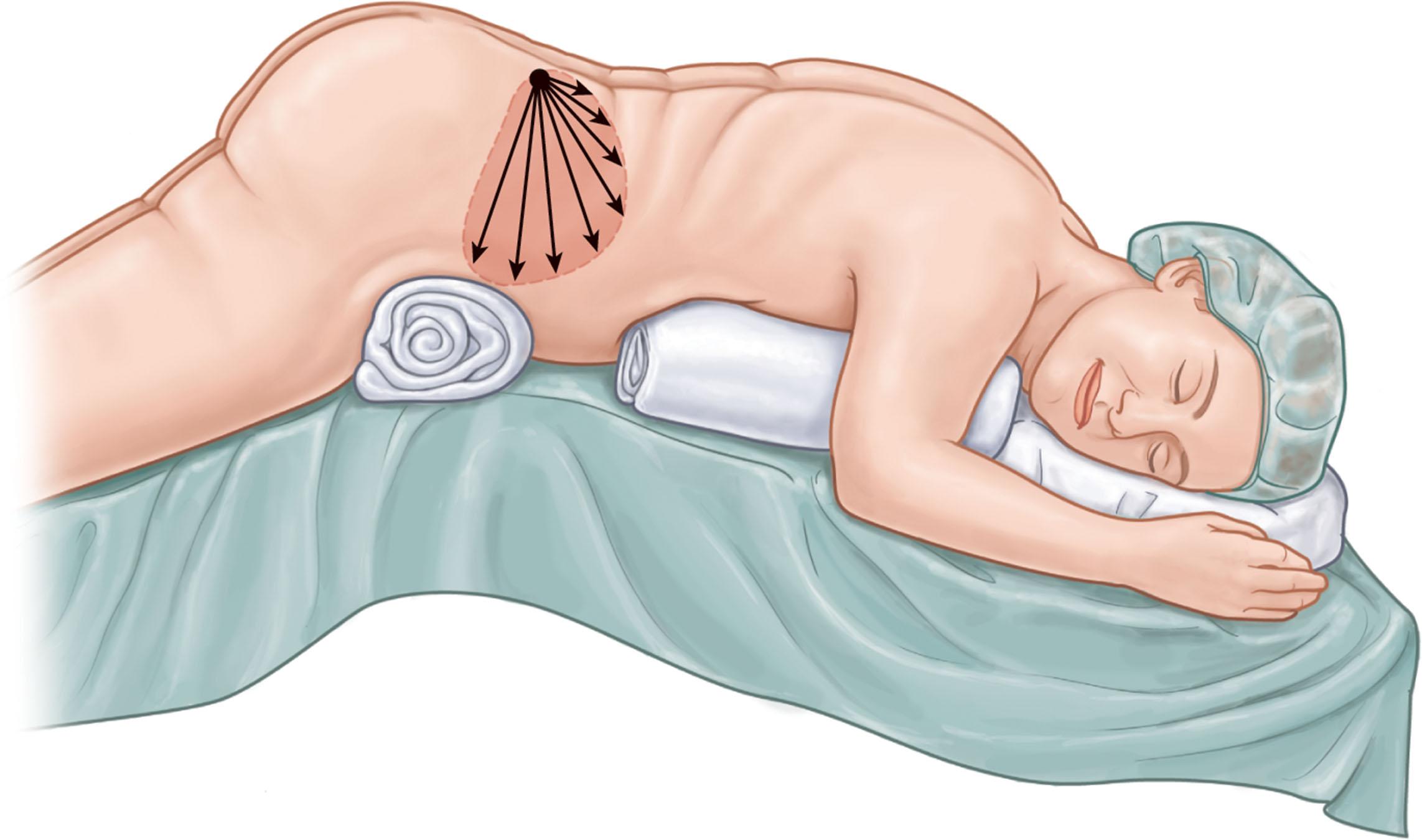
The patient's arms are carefully placed on padded arm boards with elbows bent and hands forward with the elbow below the level of the axilla to decrease potential positional risk injury such as direct pressure injury or nerve stretch injury. The face must be appropriately padded, including placing the cervical spine in a neutral position and protecting the globes. Patients in the prone position are subjected to pressure changes over the forehead, malar areas, iliac crest, and bony prominences of the arms and legs. Special attention also needs to be given to the female and male genitals. In the prone position, up to 70% of the contouring can be performed and may include liposuction of the arms, back, hips/flanks, lateral, posterior, and medial thighs.
With the patient in the supine position, the remainder of the trunk and extremities can be addressed. This may include treatment of the chest, arms, abdomen, anterior medial thighs, and knees. The hips and knees should be flexed at approximately 30° with a pillow. Pressure points in the supine position include the occiput, scapula, posterior iliac crest, sacrum, and heels. Regardless of prone or supine position, careful attention should be paid to pressure points, maintaining joints with normal range of motion, and adequate coverage of patient with warming devices or blankets.
The lateral decubitus position can access the flanks, lateral back, buttocks, thighs, and lower legs. A disadvantage of this method, in our experience, is that a side-by-side comparison to the contralateral area is not available to assess symmetry. Additionally, gravity impacts contour with respect to tissue position and may lead to undertreating an area if not appropriately accounted for. That being said, each surgeon should choose the positioning that allows him or her to best accomplish the goals of the patient.
Become a Clinical Tree membership for Full access and enjoy Unlimited articles
If you are a member. Log in here